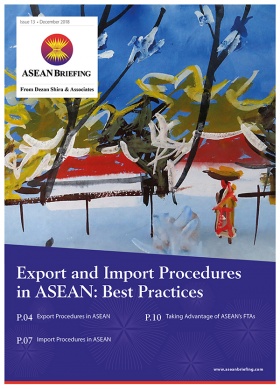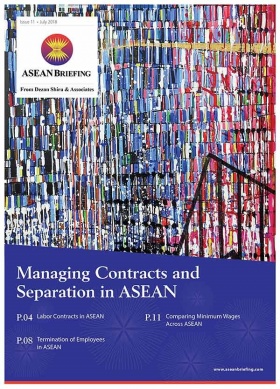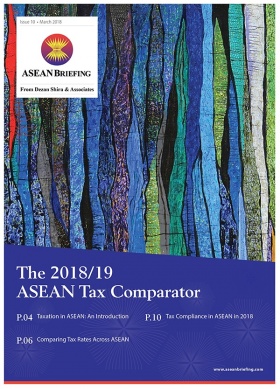ASEAN as Asia’s New Manufacturing Hub: Too Good to be True?
Earlier this year in May, the American Chamber of Commerce in China found that 40 percent of its surveyed members had either begun to shift their production outside of China or were thinking of shifting their production out of the country. Of those planning to leave China, more than half listed Southeast Asia as the location they are considering relocating to.
Some bearish investors raise eyebrows at the idea of a move to an ASEAN country as being truly profitable. They claim ASEAN countries lack China’s developed supply chain, and the infrastructure necessary to support a burgeoning industrial sector. Some have gone so far as to say investing in ASEAN is like investing in China back in the 1990s, or the early 2000s at best.
For many, it all boils down to the simple question: can companies be as productive in ASEAN as they were in China, or can’t they?
While there are many ways to guess the productivity of a country, we want to look at just the statistics and see what they have to say about where productivity lies in ASEAN.
Vietnam
When placed side-by-side to other ASEAN nations over the past 50 or so years, Vietnam’s productivity appears lackluster. According to a 2017 report by the Asian Productivity Organization, Vietnam brought up the rear of the region – if measured by GDP per worker – at only US$ 9,000 per worker (96 percent lower than the US).
However, in the past 10 years, Vietnam has bucked the curve in almost every measurable category in terms of productivity growth. When measuring for growth rates of GDP per hour worked between 2010-2017, China records 7 percent, which is followed closely by Vietnam at 5.8 percent.China lost points over the previous decade while Vietnam improved. If measuring for total factor productivity (TFP), or the flow of services from capital input from 2010-2017, Vietnam was also on China’s heels at 1.8 percent compared to China’s 2.5.
While there has been a lot of optimism surrounding supply chain shifts to Vietnam, critics are worried that a move south means hitting a total reset on operations. The Wall Street Journal ran an article in August of 2019 offering a bleak outlook for the country’s manufacturing landscape. It highlighted Vietnam’s overstuffed ports and diminutive workforce in comparison to its northern neighbor, China.
But Vietnam has been a go-to for investors transitioning out of China for quite some time now. Long before the US-China trade war, low-value and labor-intensive work in industries like garments and footwear has been moving quietly over the border to Vietnam and Cambodia. Nike has been in the country since the mid-1990s. Manufacturing, at least in garments, has easily been around for almost 30 years.
Whether it’s because of an increasingly skilled workforce, improved infrastructure, pro-business policy decisions, close proximity to China, or a combination of the reasons, Vietnam seems ready to step up as the ASEAN alternative to Chinese manufacturing.
Thailand
After Vietnam, Thailand has been the second biggest driver of regional productivity growth in the past decade, at a 5.3 percent increase in GDP per hour worked between 2010-2017.
By most other metrics it tends to take on a steady place in the center of the ASEAN pack, with only 0.6 percent TFP growth from 2010-2017, up from -0.3 percent over the previous two decades. This 0.6 percent TFP growth is still higher than the overall 0 percent average TFP growth from ASEAN nations. The majority of its economic growth reportedly stems from an increase in labor productivity.
Aside from uncertainty regarding its political climate, investment concerns for Thailand generally relate to how the country’s strong currency affects its overbearing tourism industry, as well as a slowing economy in the face of China economic slowdown.
Other sources say Thailand needs to switch to more industry automation or else risk slowing growth due to a declining local population.
Thailand has an extremely export-heavy economy, accounting for roughly two-thirds of its GDP. A slowdown in the economy of any neighboring country (like China) is immediately felt at home.
In terms of infrastructure, Thailand is a good deal more developed than its neighbors and can expect some overall slowdown in growth while it focuses on upping per-worker productivity. Labor costs have been increasing locally and will likely continue to rise.
Malaysia
In terms of worker productivity, Malaysia is one of the top ASEAN regional performers, with a 2017 GDP-per-worker of US$ 49,000. More than double the amount of China’s US$ 21,000 per-worker.
For other measurements like GDP growth per hour worked, Malaysia performed more closely with highly developed countries – like Singapore, Hong Kong, and the US – at 2.5 percent from 2010-2017. In terms of TFP productivity growth, the country was at 0.7 percent in 2017, neck-and-neck with the US and only a 0.2 percent increase from 1970 levels.
Malaysia’s recent economic slowdown in the first half of 2019 has worried some investors who believe the country has become too intertwined with China. Malaysia has recently run slightly afoul of Chinese foreign policy due to recent cancellation of the China-backed high-speed rail system set to connect the country to Singapore.
Other critics say that the nation’s easy access to low-skill labor has hindered the nation’s ability to invest in automation and other forms of upgraded production technology.
After having enjoyed eight percent growth for eight years through the ’90s, the country is safely considered an up-and-coming powerhouse with a good manufacturing base and infrastructure.
In terms of productivity, Malaysia likely finds itself in much of a similar situation to Thailand. Though it still has a large, low-cost labor force, it is seeing a slowdown in expansion and will likely need to increase mechanization in the manufacturing sector to maintain productivity growth.
Indonesia
Indonesia’s growth rates are downright troubling when stacked up with the rest of the region by almost any metric for productivity.
In terms of GDP growth per hours worked from 2010-2017, Indonesia was at the back of the pack in ASEAN with 3.8 percent growth, only slightly above Malaysia. It also led the ASEAN plus China pack in terms of its increase in total hours worked (3.2 percent).
For TFP growth from 2010-2017, Indonesia was the only major ASEAN nation seeing negative growth at -1.5 percent.
While overall foreign investment in the region is growing, many doubt the US-China trade war will have any positive impact on Indonesia’s economy or make it a more viable option for manufacturers due to its close trade ties to China.
In a South China Morning Post opinion piece, an associate at the Institute for Development of Economics and Finance in Jakarta points out that Indonesia actually lost foreign direct investment between the winter of 2018 and the spring of 2019. The piece said that Indonesia needs to establish a better regional trade network if it wants to bring foreign manufacturers into the country.Though Indonesia’s ability to become a reliable source for productivity appears questionable at present, the country arguably has the most growth potential out of all the ASEAN countries.
It possesses the fourth-largest population in the world. There may also be some hope for greater investment in the country due to the government’s state interest in loosening protections on local trade to further open the economy to foreign businesses.
Philippines
While growth in the Philippines has not been as strong as in Vietnam or Thailand, it has been expanding at a respectable pace. Placed on a labor-to-energy productivity curve, the Philippines performs like a less-developed nation, with high energy productivity compared to labor productivity.
In terms of GDP per worker for 2017, the Philippines was a mid-level regional performer at about US$ 17,000 per worker. For GDP growth per hour worked from 2010-2017, the Philippines also held the middle ground with 4.1 percent. It has, however, had some of the largest long-term regional growth in this area, growing from an overall 1.7 percent between 1990-2010.
For TFP growth in the 2010-2017 period, the Philippines experienced some of the strongest overall growth in the ASEAN at 1.4 percent, compared 0.2 percent in the 1990-2010 period.
Opinions on the outlook for the Philippines appear to be somewhat polarized. The Philippines’ Socioeconomic Planning Secretary Ernesto Pernia wrote in a recent article that a trade war would have a positive net effect at home, claiming the country would stand to gain millions of dollars in exports to the US, mainly from electronic goods.
Critics, however, point out that the past growth period has shown a significantly smaller GDP growth than predicted and programs like “Build, Build, Build” have not only underperformed, but are also likely to be primarily funded by foreign entities, such as under the Chinese Belt and Road Initiative.
Still, a Deloitte report predicted the Philippines would outperform the rest of the region over the next 20 years.
Of the major ASEAN nations, the Philippines is one of the least developed in terms of overall infrastructure. However, low development means lots of room for growth. Seeing as the Philippines is already keeping pace with the rest of the region, it seems possible that it could reach a much higher level of growth than its neighbors in the next couple of years.
Singapore
Singapore’s per-worker GDP in 2017 surpassed many developed countries, though it experienced one of the region’s widest gaps between average GDP per worker and average GDP growth per hour worked.
In terms of GDP increase per hour worked for the 2010-2017 period, Singapore saw a small slump from its 1990-2010 numbers dropping from 2.8 to 2.4 percent.
For Singapore’s 2010-2017 TFP growth, it remained marginally ahead of the ASEAN average at 0.3 percent growth.
Growth forecasts for 2019 have been exceptionally poor for Singapore due to anticipated economic slowdown from their biggest trading partner, China. This year, Moody’s ranked Singapore as the third most vulnerable Asia-Pacific country due to a slowdown in Chinese demand, after Mongolia.
Despite this gloomy outlook, commentators are mostly quite positive about Singapore’s prospects. Some critics say that growth is just a matter of Singapore further exploring its trade options, like the new Singapore-EU FTA or greater investment from businesses in new agreements like the ASEAN Smart Cities Network.
As a member of the “Asian Tigers” group of countries, Singapore is in a much more advanced stage of development than the rest of the ASEAN. This means productivity in Singapore is much more comparable to the US or other developed countries in terms of industrial investment.
What Does it Mean for Production?
Investors should keep in mind that a move to the ASEAN can never mean cutting China completely out of the picture. The world’s second-largest economy and largest consumer base is a much more alluring regional market than anything the rest of the world currently has to offer.
Foreign businesses in China often find they can easily replace US customers with local customers as the country continues to develop.
While infrastructure and politics in ASEAN can sometimes seem like a step into China’s past, it is important to remember that these countries have not simply been stuck in a vacuum since the 1980s. They are home to longstanding trade networks, and international businesses that rival the best China has to offer. They also host an increasingly well-educated, young workforce and growing middle class.
With the help of a trusted local advisor who understands the local business landscape, forward-thinking investors have a wide range of opportunities in the region to take advantage of.
About Us
ASEAN Briefing is produced by Dezan Shira & Associates. The firm assists foreign investors throughout Asia and maintains offices throughout ASEAN, including in Singapore, Hanoi, Ho Chi Minh City and Jakarta. Please contact us at asia@dezshira.com or visit our website at www.dezshira.com.







